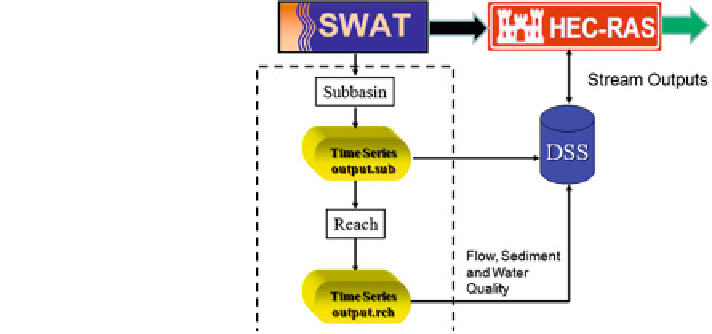Environmental Engineering Reference
In-Depth Information
composite constituents. In addition, NSM III incorporates a dynamic bed sediment
diagenesis component, which simulates the chemical and biological processes
undergone at the sediment-water interface after sediments are deposited. The
schematic representation of HEC-RAS NSM I water quality processes is shown
Fig.
10.5
.
The
conservation-of-mass
equation
in
HEC-RAS
is
solved
using
QUICKEST-ULTIMATE transport algorithm.
10.3.3 Integration of SWAT and HEC-RAS
Although SWAT includes riverine water hydraulic and water quality capabilities,
the demands of tracking the dynamic transport and fate of nutrients and/or the
specific characteristics of the receiving water system required additional capabil-
ities not available within SWAT in order to address real-world water management
concerns. Figure
10.6
shows a framework of integrated SWAT and HEC-RAS
modeling system. Evaluation of the transport and fate of nutrients in the watershed
was broken into the following steps:
1. Simulation of the 8 digit HUCs was conducted using a SWAT model
2. Extraction of time series SWAT outputs of runoff and water quality from each HUC
watershed along the mainstem and used as boundary conditions to HEC-RAS.
3. Simulation of the Mainstem River Using a HEC-RAS Model
4. Assess the potential impacts of nutrient loading and land use changes in the basin.
As shown in Fig.
10.6
, SWAT is linked to the HEC-RAS model providing
tributary discharge and contaminant loads to the HEC-RAS model. Once the
SWAT model was satisfactorily developed and calibrated the SWAT model results
are imported into the Hydraulic Engineering Center's Data Storage System (HEC-
DSS) through an interface (Fig.
10.7
). For the HEC-RAS model, SWAT provides
discharge and contaminant loads from the major streams and drainages tributary to
Fig. 10.6 Integated SWAT
and HEC-RAS modeling
system

Search WWH ::

Custom Search